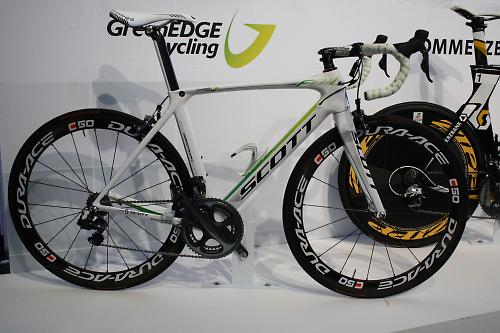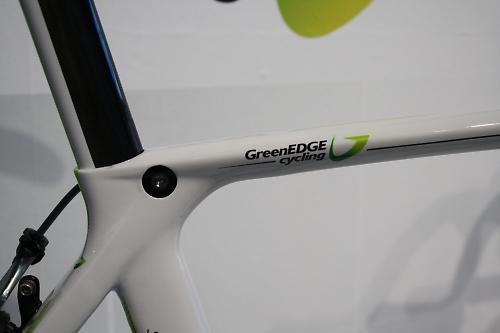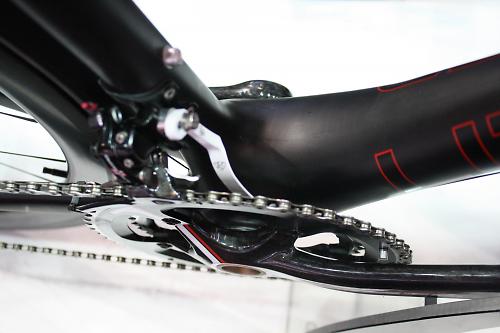- News
- Reviews
- Bikes
- Components
- Bar tape & grips
- Bottom brackets
- Brake & gear cables
- Brake & STI levers
- Brake pads & spares
- Brakes
- Cassettes & freewheels
- Chains
- Chainsets & chainrings
- Derailleurs - front
- Derailleurs - rear
- Forks
- Gear levers & shifters
- Groupsets
- Handlebars & extensions
- Headsets
- Hubs
- Inner tubes
- Pedals
- Quick releases & skewers
- Saddles
- Seatposts
- Stems
- Wheels
- Tyres
- Tubeless valves
- Accessories
- Accessories - misc
- Computer mounts
- Bags
- Bar ends
- Bike bags & cases
- Bottle cages
- Bottles
- Cameras
- Car racks
- Child seats
- Computers
- Glasses
- GPS units
- Helmets
- Lights - front
- Lights - rear
- Lights - sets
- Locks
- Mirrors
- Mudguards
- Racks
- Pumps & CO2 inflators
- Puncture kits
- Reflectives
- Smart watches
- Stands and racks
- Trailers
- Clothing
- Health, fitness and nutrition
- Tools and workshop
- Miscellaneous
- Buyers Guides
- Features
- Forum
- Recommends
- Podcast
TECH NEWS
 Cervelo R5 and S5 riding.jpg
Cervelo R5 and S5 riding.jpgEurobike 2011: The big road bike trends
It's official: next year's road bikes will be stiffer, lighter, comfier, slipperier, and electronic-ier than ever before. Eurobike is over a week ago and we've had time to digest it all and discern where the whole road bike market is heading next. Here's the shape of things to come...
One of the big trends is the move towards electronic shifting. The main reason for this is the launch of Shimano’s Ultegra Di2 groupset which we’ve reported on extensively in the past. Ultegra Di2 might not be cheap but it’s about half the price of Dura-Ace Di2 and even a little cheaper than mechanical Dura-Ace, so electronic shifting becomes an option for non-professionals for the first time. Well-heeled non-professionals, admittedly.

Pretty much every major manufacturer has at least one Ultegra Di2-equipped road bike in the range for 2012. Here’s the Felt F2, for example, which will set you back £3,499. Yes, that’s way more than most of us are ever going to spend on a bike but it does show that electronic shifting is moving closer towards the mainstream. How long until 105 Di2? Who knows? But it really wouldn’t surprise us if a team at Shimano was working on it right now.

Germany’s Canyon are speccing Ultegra Di2 on an aluminium bike, the super-stiff Ultimate AL which we got to try at the Eurobike Demo Day. It’s the only alloy bike we’ve heard of so far that features the new system although we’re sure that there will be others.

Unfortunately, Canyon haven’t yet set prices for the 2012 bikes yet although, for what it’s worth, last year’s version with a mechanical Ultegra group was £1,409.

The other electronic development on display at Eurobike was Campagnolo’s new system, although that’s still work in progress. “Campagnolo electronic drivetrain is coming. Stay tuned,” is Campag’s official line. In other words, “Keep the faith; we’re nearly there.”

How close are Campagnolo to getting their system to market? Team Movistar have been racing with it all season and Campag and Pinarello both had it on their Eurobike stands – so pretty close. Campagnolo told us we can expect it to be launched before the Giro.

Amongst those that design and build carbon bikes there are two schools of thought on where things go next. Some reckon we'll have another big leap forward in terms of materials technology and design. Others point to the slow aggregation of marginal gains in the wind tunnel and the manufacturing process which over time will further boost handling and performance while dropping weight – although most people seem to think there is a natural limit on how light a bike can go without affecting the handling. All seem agreed that we should expect carbon bikes to improve in the next few years as much as they have done in the past 10. The only potential fly in the ointment is the UCI.
Right now though aero is where it's at with even more companies clambering aboard the aero-optimised bandwagon. The aero road thing is all about reducing drag to make the bikes slip through the air more easily.

We had a look at Cervélo’s S5 when it made its first appearance back at the Tour de France and we had the chance to check it out properly at Eurobike, and take it for a spin.

You get a cutaway seat tube like you find on a time trial bike, a dropped down tube, a skinny hourglass head tube and an aero seat post, plus a whole bunch of other aero features.

A new version of the R5 was also launched at Eurobike – the lighter and stiffer VWD (Vroomen White Design) model that will be available from November.

Scott’s Foil has been around for a few months now but it’s worth taking a look at because of its aero features. The Foil doesn’t have the appearance of an aerodynamic bike – but if there’s one thing we know about aerodynamics it’s that appearance doesn’t enter into it.

Scott have given the tubes an aero profile but then cut the back end off – a little bit like Trek do with the Kammtail Virtual Foil profiles of their Speed Concept time trial bike. The shape mimics a larger aerofoil, according to Scott and gives them an aero design that’s stiff and light, and within the UCI’s rules on tube shaping.

Ridley have pushed the aero credentials of their Noah further with the addition of brakes that are integrated into the fork and the chainstays. They’re cantilevers called F-brakes – F for fast – and the idea is that there’s a minimal amount of material extending outwards to catch the wind.

Head tubes have been getting wider on high-end road bikes for a while now and that trend continues into 2012. Nearly every bike used in the pro peloton, for example, has a head tube that flares outwards to provide extra front end stiffness – the Cervélo S5 with a 1 1/8in bearing at both the top and bottom being a notable exception.
Giant’s TCR range now includes new OverDrive 2 technology. The original Overdrive used a 1 1/8in bearing at the top and 1 1/4in bearing at the bottom. OverDrive 2 uses 1 1/4in and 1 1/2in – which is the same as Canyon use on their One One Six design, incidentally. Giant reckon that it boosts steering precision by up to 40%.
(Wilier, by the way, have stepped back a bit from massively tapered head tubes, returning to 1 1/4in at the bottom on the Zero .7).

Bottom brackets continue to increase in size too. BB30 has become dominant at the very top level over the past few years and more bikes than ever are going down this route for 2012. Canyon’s Ultimate AL gets BB30 on the Campag models, for example, and BB91 on the Shimano ones.

Now, though, bottom brackets are getting even bigger again with the Wilier Zero .7, Litespeed L1R (above) and BH Ultralight all coming out with the new BB386 standard for even greater stiffness.

Oh, and there’s more internal cabling than ever before too. Di2 is partly responsible for that. If a manufacturer has to develop a way of running those wires inside the tubes, it’s a small step to do the same for mechanical cables. So the Viner Maxima 2, for example, gets internal cabling for 2012…

…As does that Canyon Ultimate AL we mentioned earlier.

As we noted last year when it comes to dropping weight and boosting stiffness the action has largely shifted to the manufacturing process. And as far as the frame manufacturing process goes for next year's models, nanotechnology is where it’s at. Nano is the buzz word of the bike industry right now. Mind you, they've been getting more and more nano crazy for the past five years or so. For 2012 nano is big… we just wanted to say that.
If you’re not familiar with nanotechnology, it essentially deals with tiny stuff (just shout if the technical jargon gets too much). For example, Giant’s Carbon Nanotube Technology used in parts of the 2012 range features a custom-blended resin with microscopic polymer particles to strengthen the material.
Everyone is at it. If the manufacturers can strengthen their carbon they can improve stiffness, or they can keep the same level of stiffness while removing material and therefore saving weight.

Italy’s De Rosa, meanwhile, are doing something else with the resin of their redesigned King RS. They’re using an ‘elastic’ resin in the high and ultra high modulus carbon fibre which, they say, allows the frame to absorb bumps and shocks.

Wilier are taking a different approach to improving comfort on their new Zero .7. They’ve added what they call SEI Film technology – Special Elastic Infiltrated Film. From what they’re saying it’s not a resin, it’s a layer that’s included between two layers of carbon. The trouble is, that’s all they’re saying. They’re not even revealing what the material is although they reckon it adds strength and durability as well as damping vibration.

At the other end of the materials spectrum (a strange concept, but go with it), there were plenty of steel road bikes at Eurobike too, including Pashley’s new £6,000 Sprinter. It’s built using handmade lugs and is said to hit the scales at 1.7kg.

The Viner range continues to feature a steel road bike too in the shape on the Aeternum which is made from Columbus XCr. Whether or not you’re a fan of steel, you have to say it’s a handsome piece of work.
Indeed, steel does seem to be back on the menu as a race bike material – we'll be talking more about that in our upcoming Italian bike round up. Canyon had a new steel road bike and they were popping up all round the place. Indeed, some of the Italian manufacturers are making the case for high-end steel bikes as a match for carbon. We'll see, but it's certainly good to see many more performance-oriented steel bikes about. Mind you, a lot – luckily not all – of those on display at Eurobike were humungously expensive too. Again, most if not all, were also all about the latest oversized steel tubing and TIG welding or fillet brazing. Aside from the new Pashley, the retro look was out.
And for 2013? Well, aero road bikes won't be going away but the trend towards making them lighter will continue… be interesting to see how green sells and if it doesn't orange is on the way followed by purple (yes, really). Mind you, this talk of exotic colours is possibly academic in our case cos more than one manufacturer said, us Brits make things easy for 'em by wanting any colour so long as it's black. Well, it is so slimming, isn't it? More black bikes for Blighty next year then… You read it here first!
Mat has been in cycling media since 1996, on titles including BikeRadar, Total Bike, Total Mountain Bike, What Mountain Bike and Mountain Biking UK, and he has been editor of 220 Triathlon and Cycling Plus. Mat has been road.cc technical editor for over a decade, testing bikes, fettling the latest kit, and trying out the most up-to-the-minute clothing. He has won his category in Ironman UK 70.3 and finished on the podium in both marathons he has run. Mat is a Cambridge graduate who did a post-grad in magazine journalism, and he is a winner of the Cycling Media Award for Specialist Online Writer. Now over 50, he's riding road and gravel bikes most days for fun and fitness rather than training for competitions.
Latest Comments
- chrisonabike 12 min 37 sec ago
I haven't cycled in Livingson (sorry) for a couple of years now, but I remembered it as a place with an extensive network of footpaths you could...
- Rendel Harris 28 min 52 sec ago
I would love to see him do it but I have my doubts; the reason he could ride away from MVdP et al yesterday was because he had softened them up...
- cyclisto 34 min 1 sec ago
Agree, this bike is what 95% need to commute, with few if any compromises at a very reasonable price. Everything is relative after all, it is high...
- Rendel Harris 34 min 48 sec ago
Thanks Steve, that's useful to know, I shall try it next week with Roubaix and hope that they don't switch to advertisements just as Pogacar puts...
- leedorney 47 min 49 sec ago
This self driving car thing or generally, I don't know why a gadget can't be invented whereby a car will see a cycle in the vicinity in the road...
- CmdrBiggles 1 hour 37 min ago
Nice they are out of the box (28-622) and easy to fit, but my first puncture, in the centreline of the tread, occurred at 133km, and it was none of...
- kcr 6 hours 59 min ago
I'd say it is an extremely rare condition for most cyclists or runners.
- ErnieC 9 hours 45 min ago
or Team Bahrain ... selective outrage.
- newbankgyratory 10 hours 47 min ago
This website offers suitable data: https://www.automobiledimension.com/large-suv-4x4-cars.php
- newbankgyratory 11 hours 20 min ago
Perhaps park the goods in a US Customs Bonded warehouse and then import them out of there when the tariff nonsense settles down?...
Add new comment
5 comments
Like the look of the Campy electronic rear mech. As usual far more style than the dated 'Robo cop' metal curves of Shimano. Just my opinion. Leave it!
I still think electronic shifting looks big and bulky.. When do they integrate batteries and gizmo's into the frame?
That would be way more neat
Besides.. I think the, what, 100g more weight using mechanical gears is worth the hassle of changing and charging batteries..
No, not a sausage
no sign of a SRAM electronic groupset then..
Nope, nothing at all on that front.